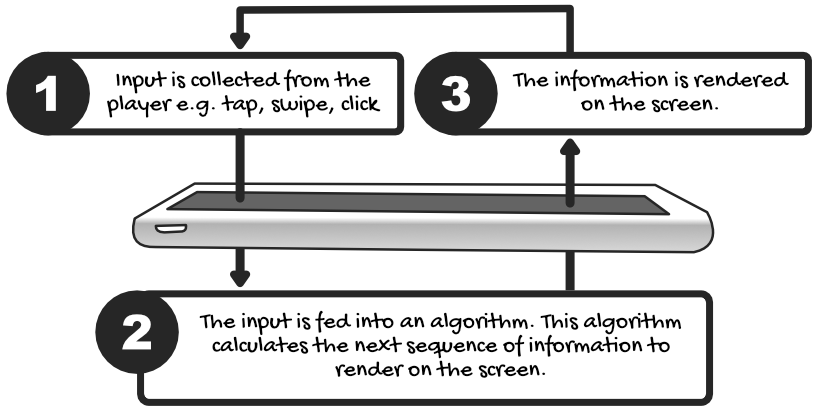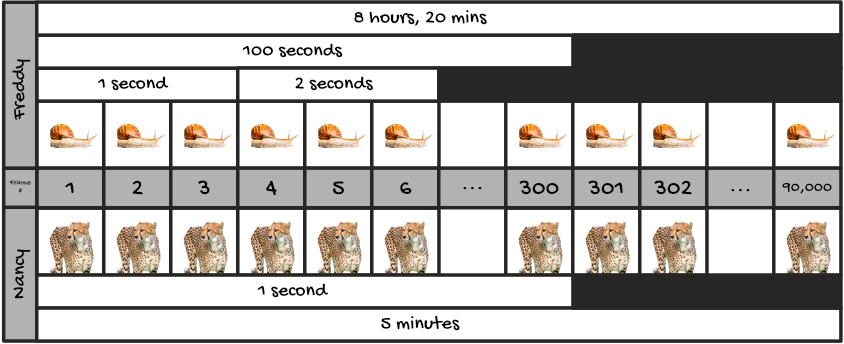I pointed to the snail, who had only moved an inch or two since we last looked. “If reality and consciousness are the same thing, then space and time do not fundamentally exist. It seems logical, then, that space and time emerge when your consciousness stitches together lower-dimensional frames of information. You know how a computer game works, right?”
Zac nodded. “I know it’s an illusion of two-dimensional frames, like a movie.”
“Yep,” I replied. “Let’s look at the difference between a game and a movie. When you’re watching a movie, you’re actually watching about 60 still frames of information flash across the screen every second. Space and time emerge when your consciousness stitches the information together. It works because each frame is so similar to the previous one.
A game does the same thing, except you can control what gets displayed in each frame. Unlike a movie, where you just sit back and passively watch the video play from beginning to end, a game allows you to change the information rendered on each frame by clicking and tapping and swiping or collecting some kind of input. Here, look at this…”
I opened up a diagram of a game loop.

I pointed to the image as I explained how it worked. “In step one, the game collects input from the player — a swipe, tap, click, shake, or any other data that can cause the game to change. In step two, the input is fed into an algorithm. The algorithm then calculates the information that needs to be rendered in the next frame of the game. Finally, in step three, that information is rendered on the screen. As the player, you observe that information and respond to it with another tap, swipe or click — and the cycle continues. This game loop runs over and over and over again — usually 30 to 60 times per second. The illusion of smooth space and time emerges when you, as the player, observe frames of information that are only slightly different from one frame to the next.
Now, I want you to imagine that Freddy the snail is a player in this game. Every time the game loop runs, his consciousness — which is just a neural network — is fed into the-”
“What’s a neural network?” Zac asked.
“A neural network is just an information processing paradigm. It essentially just takes in raw data and gives it meaning. For now, think of it as a set of beliefs. For example, based on all the information entering your senses, your consciousness currently believes you are standing in a park, talking to me, and looking at a snail. Now think about that from Freddy’s perspective. Based on all the information entering his senses, he currently believes he is slithering across a stone surface.”
Zac nodded. “Okay, got it. I currently believe I’m standing here, talking to you. And you currently believe you’re standing here, talking to me.”
“Yes,” I said. “Based on all the information entering my senses, that’s the model of reality that my consciousness — or my neural network — has formed.
Now let’s focus back on Freddy the snail for a moment. Imagine he is in a computer game, so his entire reality is constructed from static frames of information. Freddy is moving so slowly through space that the degree of difference between each frame of the game is infinitesimally small.”
We both moved our heads within inches of Freddy, whose hard shell and sluggish body were softly illuminated in the moonlight.
“If you’re moving this slowly through space,” I continued, “you could probably get away with a frame rate of, say, 3 frames per second. For every second of time that Freddy experiences, he has gone through just 3 game loops. At 3 fps, Freddy would experience a perfectly smooth and continuous reality. The amount of change — or ‘delta’ — between each still frame of reality is so small that anything more than 3 fps would be overkill.”
“Roger that,” Zac said as he stared at the slimy trail marking Freddy’s route.
“Now,” I said, “imagine you are a cheetah in the same game. You run through the world at up to 70 miles per hour, which is as fast as a car going down the highway. If a cheetah tried to observe the world at a frame rate of 3 fps, her reality would glitch! The illusion of smooth space and time would break because the degree of difference between each frame would be too great. She’d be at location A, then suddenly arrive at location B, then suddenly arrive at location C. So if you were the game developer in this situation, what would you do?”
“I’d give the cheetah a higher frame rate,” Zac said.
“Exactly! The faster an observer moves through space, the higher its frame rate needs to be. To keep the math simple, let’s say the cheetah needs to observe reality at a frame rate of 300 fps. This solution actually creates a big problem for the universe. It has all kinds of observers moving through ‘space’ at different speeds relative to each other, and therefore requiring different frame rates.”
“I don’t get what the problem is,” Zac said. “Just give every observer the highest frame rate. If the cheetah is the fastest observer and needs 300 fps, just give the snail a frame rate of 300 fps as well. Boom. Problem solved.”
“Actually,” I held up a finger, “the problem is not solved. You’ve just placed all observers on the same frame rate, which means every observer will have the same experience of space and time. However, you’ve also created a very unparsimonious, computationally inefficient game.”
“Oh! I see where you’re going with this!” Zac said. “Higher frame rates are more computationally expensive. That’s why fast-paced action games require better computers to run on. The more action and change in the game, the more computation is required.”
“Exactly! Higher frame rates use more resources, and we know the universe hates using resources it doesn’t have to. It is perfectly parsimonious. The last thing the universe would do is put every observer on the same frame rate because that decision defies the principle of least action. Giving a snail the same frame rate as a cheetah is overkill.
Instead, a parsimonious universe would utilize variable frame rates. It would give the snail a frame rate of 3 fps and the cheetah a frame rate of 300 fps. The frame rate would fluctuate depending on how fast the observer is moving through space, relative to everything else.
This architecture uses the minimum amount of resources, so it is perfectly parsimonious. However, it also places space and time on the continuum Einstein called spacetime, thus giving us special relativity. To illustrate this, let’s say Freddy here meets a sexy cheetah on Tinder.”
Zac sighed. “The world is full of sexy cheaters. They’ll break your heart.” He wistfully stared off into the harbor.
“Well done. You’re very punny.”
“Thank you,” he beamed.
“So, Freddy meets a cheetah named Nancy on Tinder. They organize to meet up in 5 minutes-”
“Well, she’s keen,” Zac interjected. “I wish my Tinder experience was like that.”
I rolled my eyes. “Freddy and Nancy organize to meet up in 5 minutes. But Freddy is observing reality at a frame rate of 3 fps, while Nancy is observing reality at a frame rate of 300 fps. So here’s a maths question for you, Zac. After 5 minutes, how many frames of reality has Nancy observed?”
“Hmm...” Zac mused. “Okay, so Nancy is observing reality at 300 fps. Therefore, 300 frames multiplied by 60 seconds multiplied by 5 minutes is 90,000 frames.”
“You’re a mathematical prodigy. Well done.”
Zac puffed out his chest.
I pressed on. “Nancy goes to meet Freddy after 5 minutes, as agreed. But Freddy is furious because he has been waiting for over 8 hours! His self-esteem is in shatters.”
“Errr… how did you get to ‘over 8 hours?’”
I showed him a diagram.

“Well, think about it. Nancy has observed 90,000 frames over the 5 minute waiting period. But Freddy is only observing reality at 3 fps. So if you take the 90,000 frames that have gone by, and divide it by Freddy’s low frame rate, you get the answer: Freddy has been waiting for 500 minutes, which is over 8 hours. Meanwhile, only 5 minutes have gone by for Nancy. Special relativity has several consequences, and that one’s called time dilation.”
“Hold up, hold up.” Zac waved his arms in the air. “That’s cool and all, but it doesn’t explain why unconscious, inanimate matter also experiences time dilation. Like, I understand that a snail and a cheetah and a human do because they are conscious observers. But what about a clock or a mango or an atom?”
“Zachary, Zachary, Zachary,” I tutted as I collapsed in a heap on the ground and began undoing my Princess Leia buns. “Have you learned nothing from our first principles exploration of reality over these past few hours? It is very dangerous to make arbitrary assumptions, like just assuming a clock or a mango or an atom is unconscious. In fact, relativity is our biggest clue that the entire universe is a giant neural network, observing itself.”
“How so?” Zac sat opposite me and fiddled with his backpack.

